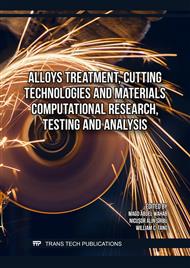p.49
p.59
p.73
p.81
p.93
p.107
p.119
p.129
p.141
Further Investigation Regarding the Use of Ultrasonic Pulse Velocity (UPV) on Earthen Elements
Abstract:
The assessment of compressive strength, and air-dry density constitutes essential parameters for evaluating the quality and performance of earthen construction materials. To ascertain these properties, this study investigates the potential application of ultrasonic testing as a non-destructive evaluation technique for earthen materials, including specimens, elements, or structures. The methodology is predicated on the measurement of ultrasonic pulse velocity (UPV), which is affected by various factors such as density, elasticity, and the curing process. By examining the propagation of ultrasonic waves through earthen samples, significant insights can be obtained regarding their drying duration, compressive strength, and density. Compressive strength is a pivotal factor in evaluating the structural integrity of earthen materials. The UPV method provides a non-destructive means to ascertain the compressive strength of earthen samples, thereby serving as a valuable instrument for quality control and assessment of earthen construction materials. Density, another critical property influencing the performance of earthen materials, can also be evaluated using the UPV method. By measuring ultrasonic pulse velocity and analyzing its correlation with density, this non-destructive approach enables rapid and efficient estimation of the compactness and quality of earthen mixtures. The ultrasonic method presents a non-destructive and efficient strategy for determining the compressive strength, and density of various soil compositions. By quantifying pulse velocity and examining its relationship with these properties, substantial insights can be garnered regarding the quality and performance of earthen construction materials. This technique holds the potential to enhance assessment and quality control processes in earthen construction, ultimately contributing to the development of more sustainable and reliable structures utilizing earthen techniques.
Info:
Periodical:
Pages:
129-139
Citation:
Online since:
November 2025
Authors:
Keywords:
Price:
Сopyright:
© 2025 Trans Tech Publications Ltd. All Rights Reserved
Share:
Citation:


